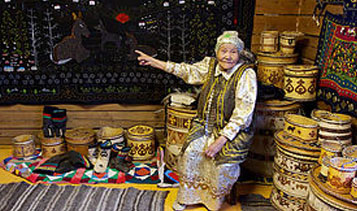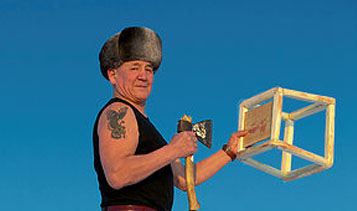Net_90°N Ω
March 25, 2018 | Galya Morrell
The net is an idea that is not fixed in space or time. It is always on the move. The net is a focal point where everything meets, yet by the time you finished reading this paragraph it has already moved on to a different coordinate. By this time next year the accumulated waste will make its way to New York, Milan or Beijing as the system is in constant flux.
This year, probably for the first time in history, the children of Young Explorers North Expedition will transform the North Pole into an art space, which merges the real with imaginary, tradition with modernity, and indigenous with exotic.
A cross-pollination of sea ice, snow, water, science, art and silence, the Net_90°N Ω is a project that fuses installation, pantomime and living environment, addressing themes such as climate change, pollution, ignorance, and apathy.
The North Pole is a mathematical abstraction, but it is real too. It represents purity and cleanliness. Never before, children, who too represent purity and cleanliness, have come together.
There is no land under our feet, only shifting ice. It’s a drifting space with no borders, where humans and animals live in unison, where there is no room for mutual destruction or hatred.
All five scenes are connected by the Net_90°N Ω. The net is the place where we are lost. Animals are lost. As are humans. Trash is caught by the net. Labyrinth is the net.
Net_90°N Ω is an attempt to create an imaginary space which will be simultaneously replicated in many other parts of the world: in Greenland, Siberia and Central Asia.
MUTATIONS
Narwhals are the most mystical animals of the Arctic, and the most vulnerable to climate change. Until the Age of Exploration, narwhals were known to medieval Europeans as Unicorns, for their tusks that were believed to be Unicorn’s horns. Brought to Europe by Vikings, narwhal tusks were sold for many times their weight than gold, and were thought to have magic powers, such as neutralizing poison and curing melancholia.
Today, because of increasing pollution in the Arctic, narwhals accumulate lead, copper and mercury in their liver, kidney, muscle and blubber. They become poisonous drifting containers; all while putting at risk their further survival.
Narwhals are very special. They navigate and hunt for food. They click, whistle and knock. But it is because of their tusk, the most sophisticated antenna, with millions of nerve endings, that they can scan the ocean environment much faster and more accurately than any modern technology can.
Narwhals are Gods of the Past, but they may be gone forever if we fail to change the way we recklessly contaminate our planet Earth. Everything you trash today in NYC or in Beijing eventually ends up and accumulate in our Narwhals.
In the Inuit folklore, the tusks of the Narwhals pointed into the sky, are a symbol of connection of the Earth with Cosmos. For us today, in our NET 90.0.07 project, they are the symbol of curiosity and exploration, and the quest for sanity which equals at the least, the end of contamination.
Cul-de-Sac
The North Pole, and the Arctic in general, is the finish line for all the plastic from all corners of the world. Brought by currents, and accelerated by climate change, it all ends here – on our Top of the World.
More than 8 million tons of plastic end up in the ocean each year, causing death and contamination of Arctic animals and humans alike.
Plastic was invented only 60 years ago. Imagine, what will happen next. And think about all the plastic that is still in transition on the way to its finish line.
In 2010 – 2018 the children of the Arctic, working with Arctic Without Borders and Expedition Avannaa, have removed more than 12 tons of garbage from the shores of Siberian mighty rivers and bays of Northern Greenland, preventing it from ending up in the Arctic Ocean.
Cul-de-Sac is a travelling project, which had started in 2008 in Chukotka, went all the way through Northern Greenland, Siberia and Central Asia, and involved hundreds of indigenous children. Now, at the North Pole, the Young Explorers North will make their case, showing the world the perils of pollution; the half that is visible and the other half that is not.
Arctic Clowns
Once upon a time, four clowns, went out for a walk on the sea ice in a little settlement of Siorapaluk, Northern Greenland. They entered an Arctic Paradise. The polar day had just begun after four long months of polar night, and the beauty of the frozen world was visible again. Icebergs, animals, and humans were celebrating the return of the Sun. But then suddenly the Nor’Easter blew, the ice broke and the clowns were adrift. Currents took them North and then even further North.
As days passed, the clowns were fighting hard to get out of the ice trap. But then, as days passed again, they gradually lost their strength, energy and courage. But they
did not lose their friendship. When one clown was breaking, the other clown was repairing.
But then, as more days passed, even hope was gone.
It was a sad morning, when the clowns suddenly noticed that the mighty drift had brought them to a very special place. It was the Top of the World. They got up from the ice, helping each other, and realized that they were on the North Pole!
All of a sudden, they were standing strong and they saw that the entire world was beneath them: such a beautiful world!
The Arctic clowns were exhausted, but now they knew what to do.
They pulled out their magic boxes and blew up their seal bubbles, which flew into Space.
Each bubble was colorful. Each reflected the Earth – as one can see it only from the North Pole.
Each flying globe contained the breath of the clowns.
It also contained their aspirations, dreams, fears, pain and love.
All these beautiful flying frozen globes became the part of the Arctic.
Silent Expedition
When you first come to the North Pole, your lips deep-freeze, your tongue gets paralyzed, and suddenly you can’t say your own name.
As the time passes your body and mind gradually adapt to the new environment. As your mind changes, your language changes too. It becomes compressed. Paragraphs condense to sentences, and sentences condense to words. Every word becomes more meaningful. It gets extra layers; it gets extra depth.
In the West silence is often seen as the absence of thought, as a sign of intellectual backwardness, of rudeness, or of absolute indifference. But in the Arctic it is different. In the Arctic you don’t need words to convey a message.
In the West you fill silence with small talk, but in the Arctic you don’t. You hear each other’s breath, and often, each other’s heartbeat. It’s an inner language, the finest instrument of communication, finer than body language. Words, compared to the sounds of your heartbeat, appear to be rudimentary instruments of communication.
In big towns we talk to impress. We talk to stand out. We talk to conquer. But as we talk we lose an ability to listen. We hear only our own voice, and we miss all the
things that are being said or rather – most importantly - not being said. Finally we get disoriented.
Arctic can do a better job.
In Arctic Without Borders we started Silent Expeditions in 2006. We would walk for miles on sea ice or frozen tundra and not say a single word. And then, exhausted we would finally lie down on the snow and look up the sky. And then suddenly we would see things that we have never noticed before. And we would hear the sounds that we have not heard earlier. They were coming from underneath the ice. We heard another world talking to us – the world that is much grander than ours.
Every single one of these expeditions was a miracle. It turned out that our ability to listen and to hear, even though it was corrupted, is still alive. We noticed that all our basic instincts that had once helped our ancestors to hear and to see things hidden behind the horizon suddenly came back. It means that the ancient knowledge is not lost forever. You just need to take a break from constant talking, and all these magical things will return.
Today we are making the first ever Silent Expedition on the North Pole with Young Explorers North. When you stop talking and start listening, you will hear the whisper of the icebergs and the talk of the fish.
Labyrinth.
Sea ice is always a labyrinth.
Yet, our labyrinth in the Arctic is not a gated community, but rather an open and endless space.
The human mind always seeks borders, which brings us into a trap, into a net.
We walk and look for exit, but we can’t find it. We feel we are trapped. We panic and again, and again we end up in the center of the Labyrinth which is a cul-de-sac, the dead end.
It’s only if you raise above the sea ice, you will see that the labyrinth stretching all the way to the horizon and beyond it.
There are many exits there, but if you stick to the centre you won’t see any and you would be trapped forever.
The answer? Don’t look under your feet, follow your heart, break gravitation and look at yourself from above. Net_90°N Ω
To know more, please follow us at
http://sites.google.com/view/youngexplorer/home?authuser=0
Tags
My blogs:




Travels with the Nomad:
October 31, 2015 | Galya Morrell
Matters of Health:
June 10, 2015 | Galya Morrell
Russian Telegraph:
May 1, 2015 | Galya Morrell
Travels with the Nomad:
October 31, 2015 | Galya Morrell
Matters of Health:
June 10, 2015 | Galya Morrell
Russian Telegraph:
May 1, 2015 | Galya Morrell





